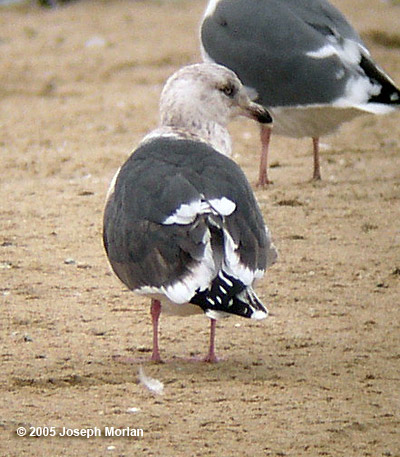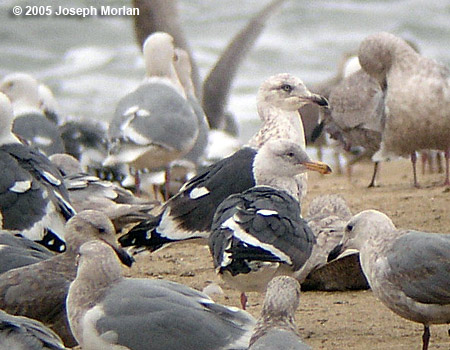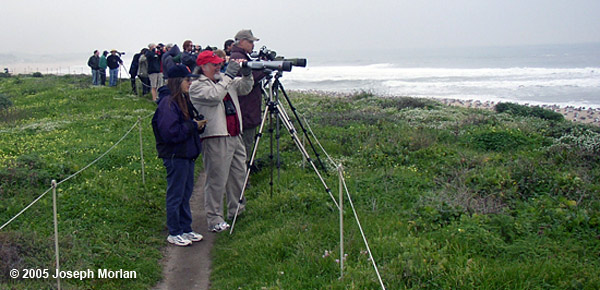Slaty-backed Gull (Larus
schistisagus)
Half Moon Bay, San Mateo County, California
21 January 2005
Joseph Morlan
Photos © 21 January 2005  by Joseph
Morlan. All rights reserved.
by Joseph
Morlan. All rights reserved.
This morning I learned from a report by David Vander Pluym that the third cycle Slaty-backed Gull found yesterday
afternoon by Alvaro Jaramillo had put in a brief appearance again. I had missed the bird yesterday, but decided
to try again this afternoon. I arrived about 1:30pm. Eventually about 25-30 birders assembled at the bluffs above
Venice Beach. As usual, there were many thousands of gulls to pick through. I saw two different Glaucous Gulls
along with many Western, Glaucous-winged, Herring, Thayer's and California gulls. Most of the birders were gathered
above the large concentration of gulls, when Brian Fitch spotted the Slaty-backed Gull near the north end of the
flock towards the top of a low dune. I was expecting a bird with a strikingly darker back than the numerous Western
Gulls and had some difficulty locating the bird at first (photo below left). Eventually we all got on the bird
and studied it for about an hour before all the birds flushed and the Slaty-backed Gull disappeared over the ocean
heading north.
Description
It was a large gull, appearing marginally smaller than adjacent Western Gulls. The mantle appeared about a half
shade darker than most of the Western Gulls (L. occidentalis occidentalis) but not noticeably darker than
the few L. o. wymani which were also in the area. With close study the gray of the Slaty-backed seemed to
lack the bluish tones on the Western Gull, possibly because of a slight brown tinge to the mantle of the Slaty-backed
(see photos). The lesser and median wing coverts were a mixture of dark  gray and brownish, but the greater coverts formed
a fairly uniform brownish panel. The secondaries and tertials were dark gray basally, with very broad white tips
forming a broader white trailing edge than on most Western Gulls. The scapulars were also very broadly tipped with
white forming conspicuous scapular crescents.
gray and brownish, but the greater coverts formed
a fairly uniform brownish panel. The secondaries and tertials were dark gray basally, with very broad white tips
forming a broader white trailing edge than on most Western Gulls. The scapulars were also very broadly tipped with
white forming conspicuous scapular crescents.
The primaries were black with small white apical spots. These spots became slightly larger on the inner primaries.
A mirror was visible on the inner web of P10 which appeared to be slightly shorter than the longest visible primary
(P9). Some of the inner primaries, especially the first primary beyond the tertial crescent had evident white tongues
on the inner webs.
The head and body were whitish with extensive dusky smudging on the underparts, nape, and head. The chin, throat
and foreneck appeared mostly unmarked white with a few faint dusky markings. The clear pale yellow eye was surrounded
by dark and showed an obvious post-ocular line imparting a fierce expression.
The tail was white with an irregular black band across the middle, mottled with whitish basally.
The bill was not quite as deep as that of the many Western Gulls, and not as distinctly arched at the tip. Instead
the culmen curved gradually from the midpoint to the hook. The gonydeal angle was moderately pronounced. The base of the bill was
pale pinkish, blending with a dark tip extending back about half way along the lower mandible. The legs and feet
were a fairly bright bubblegum pink.
gonydeal angle was moderately pronounced. The base of the bill was
pale pinkish, blending with a dark tip extending back about half way along the lower mandible. The legs and feet
were a fairly bright bubblegum pink.
Structurally the bird appeared short-legged, pot-bellied, short winged, and bull-necked compared to adjacent
Western Gulls. Also the forehead usually appeared more sloped than other species.
Better photos from yesterday, along with more thorough analysis have been posted by Al Jaramillo here.
There were many other observers taking photographs while I was there (crowd shot below). Some photos taken by Rick
Lebadour showed the spread wings along with a slight "string of pearls" pattern. Don Roberson has posted
additional details and photos of today's sighting here.
Jeff Poklen has posted two additional images here.
Discussion
This is the second Slaty-backed Gull I have seen at this location within the last two weeks. I have posted details
and aphoto of the first bird along with an itemized list and discussion of previous reports of this species in
California here. 
In conversation with other observers who had seen this individual previously, it appears that the bird's mantle
seemed less obviously dark this afternoon because of the overcast lighting conditions compared to bright sunlight
earlier. Evidently the bright light may enhance the contrast; but I do not completely understand the causes of
this effect. Earlier the bird had been described as "jumping out" as different. I confess that I panned
my scope across the field of view and missed this bird several times when I was trying to locate or relocate it.
It did not "jump out" under this afternoon's lighting conditions. This bird also struck me as somewhat
paler mantled than my recollection of adults on St. Paul Island, Alaska. However photos
of those birds taken by Mike Rogers seem reasonably consistent with today's bird.
The possibility of Slaty-backed X Glaucous-winged Gull deserves some consideration. In discussion with other
observers, there was a consensus that such a hybrid should show more obvious hybrid characters, such as paler wing-tips.
Another possibility might be a hybrid combination of Slaty-backed X Herring Gull. I have no specific knowledge
of such hybrids and remain uncertain about the range of variation within pure Slaty-backed Gulls.
Update
The bird was seen again by numerous observers on Saturday 22 January. Martin Meyers has posted some excellent
photos showing spread wings, tail and underwings here.
 by Joseph
Morlan. All rights reserved.
by Joseph
Morlan. All rights reserved. gray and brownish, but the greater coverts formed
a fairly uniform brownish panel. The secondaries and tertials were dark gray basally, with very broad white tips
forming a broader white trailing edge than on most Western Gulls. The scapulars were also very broadly tipped with
white forming conspicuous scapular crescents.
gray and brownish, but the greater coverts formed
a fairly uniform brownish panel. The secondaries and tertials were dark gray basally, with very broad white tips
forming a broader white trailing edge than on most Western Gulls. The scapulars were also very broadly tipped with
white forming conspicuous scapular crescents. gonydeal angle was moderately pronounced. The base of the bill was
pale pinkish, blending with a dark tip extending back about half way along the lower mandible. The legs and feet
were a fairly bright bubblegum pink.
gonydeal angle was moderately pronounced. The base of the bill was
pale pinkish, blending with a dark tip extending back about half way along the lower mandible. The legs and feet
were a fairly bright bubblegum pink.